Robert George Mason, 1849 - 1912
by Brian Stevenson
last updated July, 2021
R.G. Mason
was a professional microscope manufacturer and preparer of microscope slides
during the last decades of the 19th century, continuing into the
early years of the 20th. Around the year 1880, Mason quit his job
with the Swift optical works and began his own business. That venture lasted
until about 1900. Mason continued to produce both prepared slides and unmounted
specimens until his death.
Mason’s
slides were consistently well made, and included a wide variety of specimen
types (Figure 1). His slides include some highly artistic preparations,
aesthetically pleasing on both microscopic and macroscopic scales. For example,
the second slide in Figure 1: a single leaf, retaining its color, dry-mounted
against a black background and centered within concentric rings of the same
colors. He even used color-matched labels.

Figure 1.
Examples of microscope slides produced by R.G. Mason. His custom-made
name labels are small and separate from the off-the-shelf specimen identification
labels, likely to save production costs. As a result, many owners have removed
Mason’s identifying label. He lived on Park Road, Clapham from 1881 until ca.
1909. The section of Primula cashmeriana leaf in the leftmost slide is still
vibrantly colored, even after 120 years. The label references the textbook
‘Natural History of Plants’, by Anton Kerner von Marilaun and translated into
English by Francis W. Oliver in 1895. The beautifully-mounted leaf next to it
is from an African herb now known as Dicerocaryum zanguebarica. Mason
extensively advertised his preparations of limestone from Llanynynech,
Montgomeryshire, Wales at the turn of the 20th century.
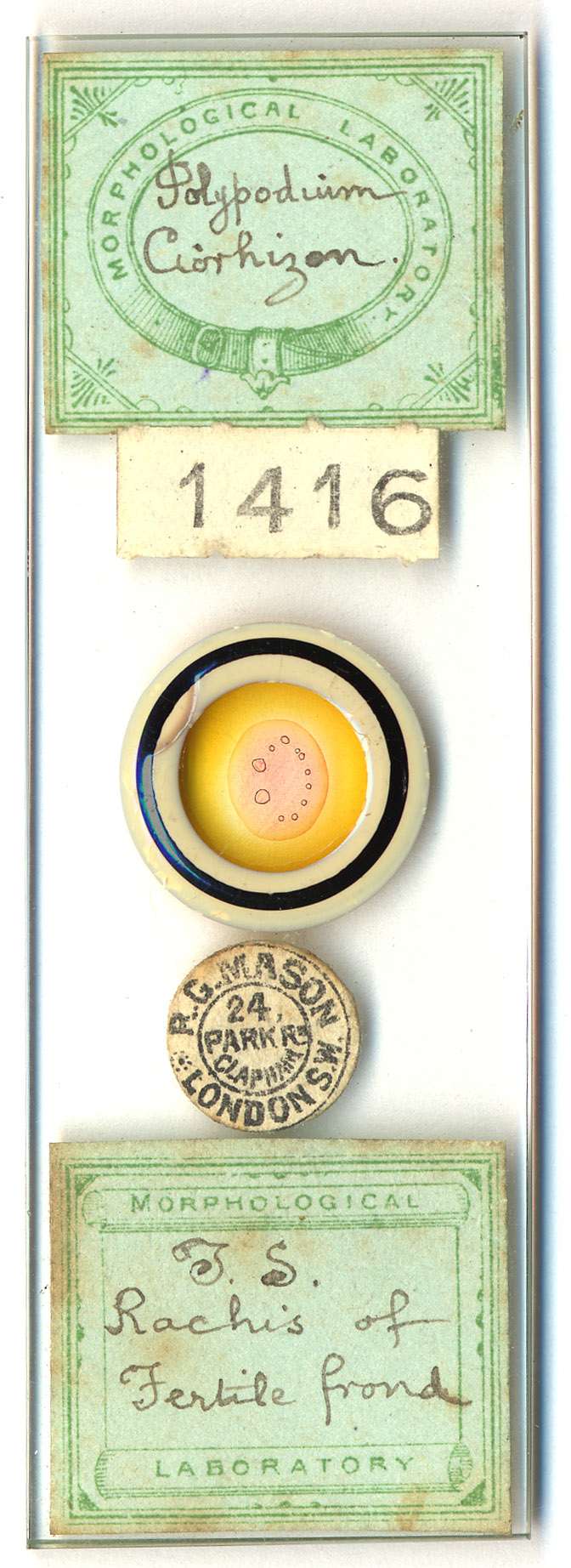
Figure 2.
A botanical microscope slide labeled by both R.G. Mason and The Morphological Laboratory, which was a London partnership between John E. Ady and Heinrich Hensoldt during 1883-1884. Arthur Doherty also had a brief partnership with Ady at that same time. As Doherty was highly skilled at preparing slides of stained botanical sections, this may have been his work. Most likely, Mason added his trade label for re-sale. The address of 24 Park Road, Clapham, dates his possession of the slide to between 1883 and ca. 1890. A similar Morphological Laboratory slide with a Mason label is illustrated in Bracegirdle’s Microscopical Mounts and Mounters, Plate 25-J.
Mason’s
microscope manufacturing and slide making business was a small affair, with him
as the only known employee. The 1891 census listed Robert Mason as being “neither employed nor employer”.
Strikingly, his 15 year-old son was recorded as being “employed” as an “optician’s
assistant”. If accurate, then the son was working for another optician,
probably as an apprentice.
His
advertisements indicated that Mason’s business began in 1880. The 1881 census
listed him as then being an “unemployed
optician”, suggesting that he was still working to get his business going.
While he presumably produced microscopes during the 1880s, I did not find any
records of what they were like. However, he was variously described as being a
“manufacturing optician to the trade”
and “a trade maker”, so he may have
been primarily a maker of unlabeled microscopes that were sold by other
retailers.
Mason made
a big splash in 1890, with the release of a hybrid microscope that functioned
as a standard table instrument and could also be connected to a light source
for use as a magnifying projector (Figures 3 and 4). The concept was not new,
but Mason’s ingenious model was constructed such that nothing needed to be
disassembled for the transition – one simply swung the base out of the way and
attached the condenser to a light projector. This invention won him a Silver
Medal at the 1893 Exhibition of the Royal Cornwall Polytechnic Society. Despite
extensive advertising and published high praises, Mason’s output appears to
have been fairly small and I have not located any evidence of surviving
microscope-lanterns. However, London’s Museum of the History of Science has a
projection microscope that was made by Mason (Figure 5).
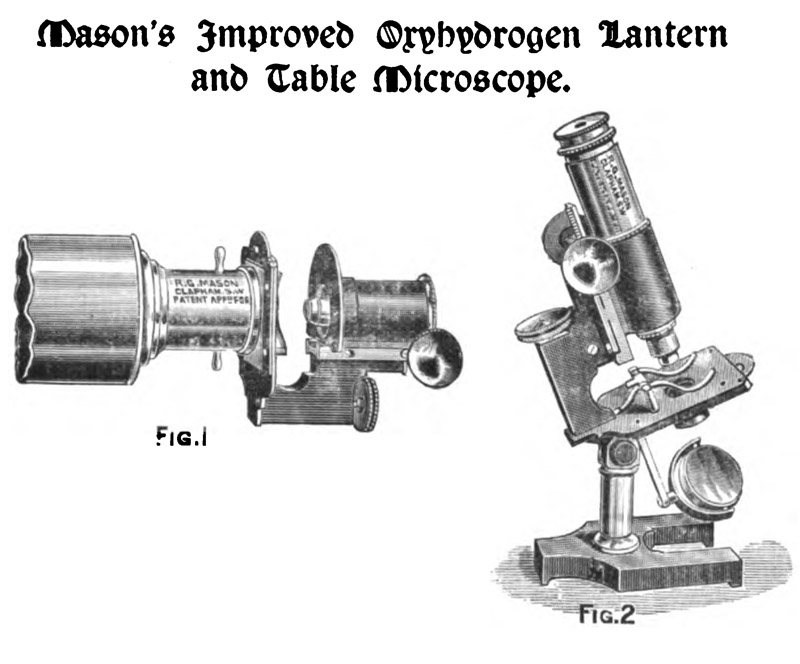
Figure 3.
As described by the Journal of the Royal Microscopical Society in 1891,
“Mr. R. G. Mason, of 69, Clapham Park Road, Clapham, S.W., has introduced the
above form of lantern and table Microscope, a patent for which has been applied
for. Until the present time the lantern Microscope has been a distinct
instrument from the table form of stand. By the union of the above parts an
instrument is obtained that, when not in use for screen projections, can be
easily altered, as shown by fig. (2). No unscrewing is required, and there are
no loose parts. Fig. (1) shows the instrument as used on the lantern. It is
very convenient for the science teacher or general lecturer, as a demonstration
may be made to either a small or large audience with equal facility. The lower
part, which carries the joint for inclining the instrument at any angle, is
fitted with concave and flat mirrors on swinging arm, also with the universal
size substage fitting tube for apparatus. The body and draw, which fits into
the upper part, is of large diameter, and is screwed with the Society's size
screw, thus enabling any ordinary microscopic objective to be used with it. It
is fitted with a first-class rack, and also screw fine motion working steadily
under high powers. This fine motion is especially useful in photomicrography.
The stage being of the usual form, both object and objective are in view, and
easily manipulated while in use, thus doing away with an objection that is
often present in the older forms of lantern Microscope. A further improvement
is a spring clip, enabling the object to be easily changed without scratching
the labels, &c., its construction admitting of either a deep zoophyte
trough or the thinnest 3x1 slip being held gently but firmly. The parts are
supplied separately, so that any one needing only the lantern arrangement can
add the other at any future time”.
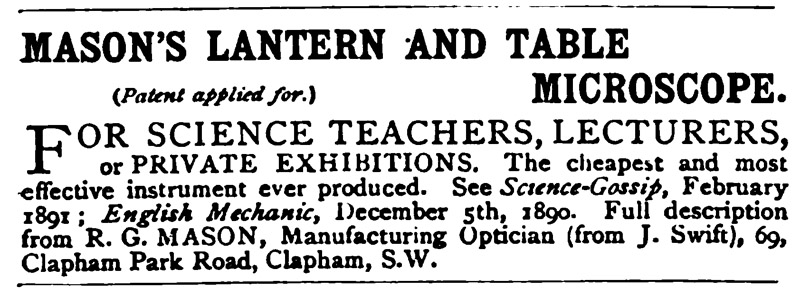
Figure 4.
Advertisement from the July, 1893 issue of Hardwicke’s Science-Gossip.
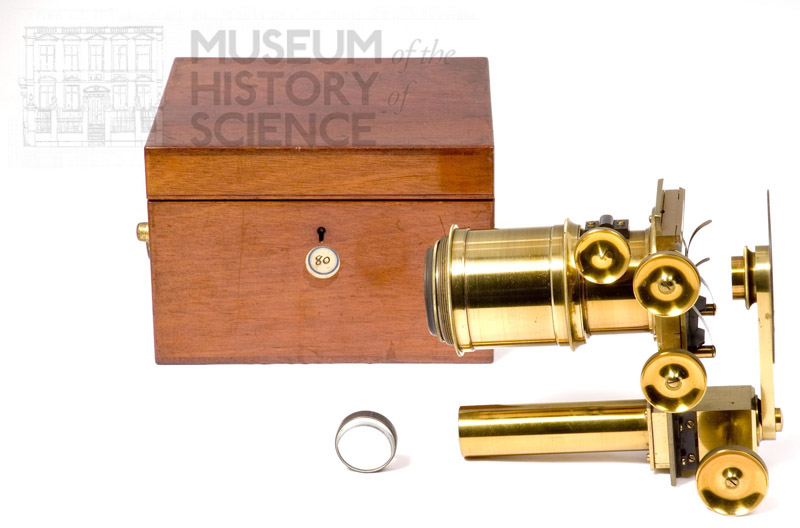
Figure 5.
A simple projection microscope by R.G. Mason. Image from the Museum of
the History of Science, used for non-profit, educational purposes in accordance
with Creative Commons understandings.
In
Victorian times, the term “optician”
was applied to any worker involved with optical devices, including microscopes.
The two major ingredients of a microscope are brass and glass, and Robert
Mason’s early training made him an expert in brass.
His
father, Robert William Mason, worked in the gun-making trades as a finish
polisher. He was evidently quite successful at that occupation, as the family
retained live-in servants. Robert George Mason was the first child, born during
1849 in the Whitechapel area of London. His mother died in 1856, possibly as a
consequence of giving birth to the family’s fourth child.
The 1871
census found Robert George boarding with a gunsmith in Enfield. Most of their
neighbors were also involved with gun-making, although one man next door was a
sword-maker. Robert, however, was an “optician”,
possibly working for a nearby telescope or microscope manufacturer.
In
addition to Robert’s upbringing, his later writing and advertisements indicate
strong, practical knowledge of brass and iron work. Figure 6 illustrates
advertisements from Mason in which he offered unfinished brass parts such that
enterprising people could build their own microscopes, offered advice on
assembling/repairing a key microscope component, and applied for a metalworking
lathe. In addition, he published advice on giving brass a black finish, coating
a mirror with mercury and silver, soldering gun-metal, case-hardening iron and many other aspects of metalworking.
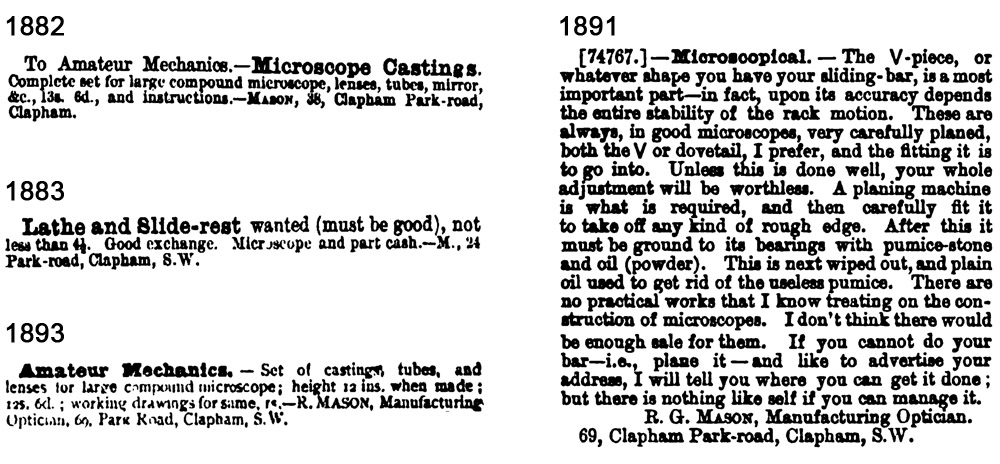
Figure 6.
Advertisements and helpful tips from R.G. Mason, indicating his
experience with brass working and microscope construction. All from The English
Mechanic and World of Science.
Mason
married in 1875, again describing his occupation as “optician”. At that time, he was living in Brighton, while his wife,
Elizabeth, was from London. Mason then moved to the London area. Since Mason
worked for Swift, they probably lived near that factory, which was on Tottenham
Court. Mason stated that he left Swift to begin his own business in 1880. He
set up the family household and his business in the same building, on Clapham
Park Road, south of the Thames. Mason remained on that road until near his
death, occupying four different buildings: number 28 from 1881 to 1882, number
38 from 1882 to 1883, number 24 from 1883 to ca. 1890, and number 69 from ca. 1890 to ca. 1909.
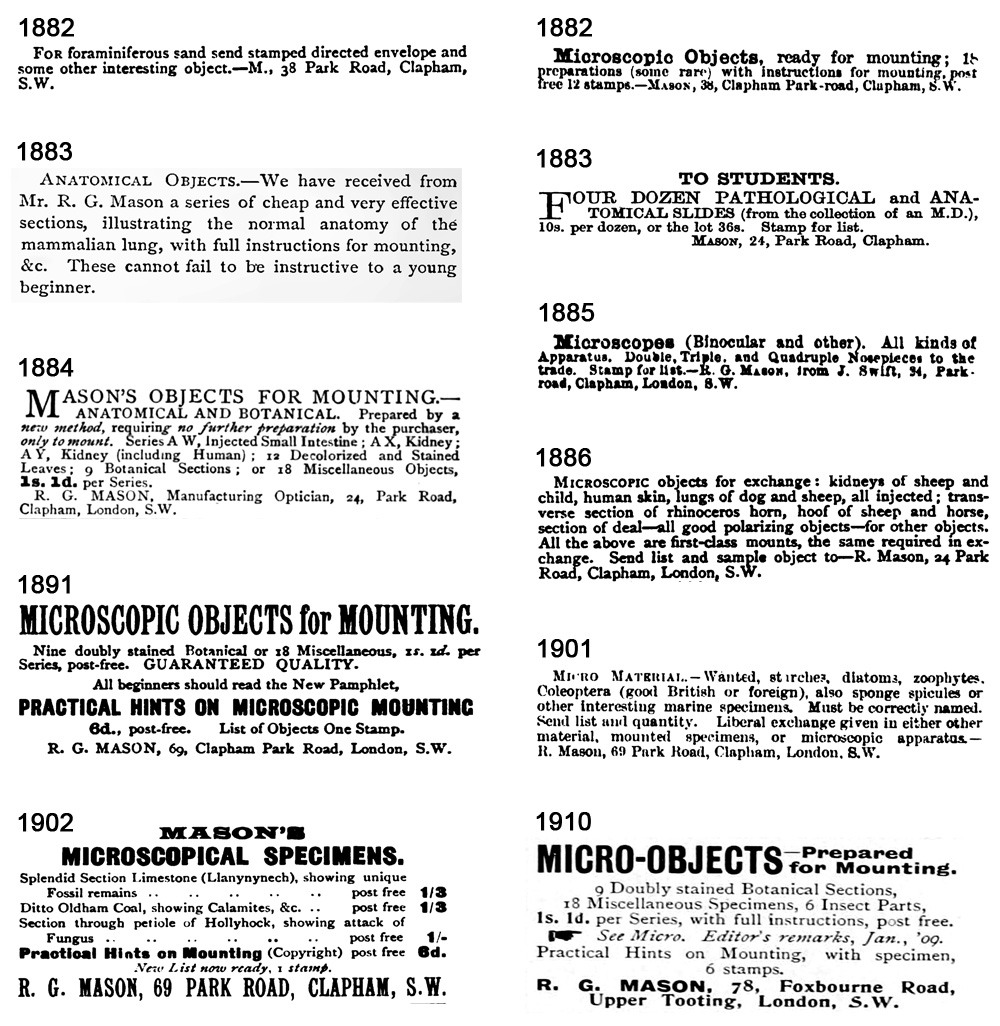
Figure 7.
Advertisements spanning Robert Mason’s career as a professional maker
of microscopes and microscope slides. His microscope manufacturing business
operated from 1880 until around 1900. The first records of his slide-making are
from 1882, and extend until just before he died.
Published
advertisements indicate that Mason sought to expand his microscope-making
business in 1882, to include specimens for slide-making (Figure 7). During that
year, he posted twice in the popular magazine Hardwicke’s Science-Gossip, offering unmounted foraminifera and
other objects in exchange for “interesting
objects”. This was a common means for slide-makers to diversify the types
of objects they could offer to customers.
Advertisements from throughout Mason’s career indicate that the primary focus of his slide business
was prepared, but unmounted, specimens. These were sold to amateurs, and
possibly other professionals, so they could make their own slides with
high-quality specimens. Mason’s first known specimens for mounting were
sections of lungs and other anatomical objects. These would have been
reasonably easy to mass-produce for a person with a decent microtome. A piece
of lung or kidney from the butcher’s shop would make a lot of specimens. Some
of the specimens were reported to be human, which could be acquired from
morticians, hospitals, doctors or medical students.
An 1883
advertisement offered a collection of pathology and anatomy slides “from the collection of an M.D.” (Figure
7). Reselling used slides was a simple source of income, and a widespread
practice among professional slide-makers.
Advertisements
from as early as 1882 state that Mason included “instructions for mounting” with his specimens, suggesting that he
knew what he was doing in that department. Within a few years, he began
offering completed, prepared microscope slides. Circa 1891, he published a
pamphlet entitled Practical Hints on Mounting.
In
addition, Mason was a frequent contributor to magazines such as The English Mechanic and World of Science,
offering tips on various aspects of microscopy and metalworking. For examples,
from 1891:
“The best method to obtain cuticles of leaves
is by soaking the leaf in soft water (rain-water). Time will vary very much,
according to specimen; hard specimens, such as Hoya carnosa, may take a month
or longer. When specimen appears to be soaked enough, take one out and try with
a needle at the base of leaf; if cuticle comes up readily go on (if not, again
immerse). Gently clear it at the extreme edge. Now lay it flat on a three by
one slip, and with a pair of forceps gently put it up towards the tip. Hold the
lower portion of the leaf on to the glass with a needle or forceps. As soon as
you have got cuticle off, place in clean water, brush with a camel-hair pencil;
if required stained, and colour is bad, bleach in chlorinated soda solution;
stain with aniline or logwood, and mount in the usual way - balsam or
glycerine. R.G. Mason, Manufacturing Optician, 69, Park-road, Clapham, S.W.”
“You will not find mounting the moth antenna
dry a very satisfactory way. It can be done in a shallow cell; but if you clean
it of dust, and soak it in spirits of turpentine for say 24 hours, you will find
this will not hurt it, and you can then mount in Balsam and benzole, or you may
take it fresh from the insect and mount it in glycerine in a cell, seal the
cell with Miller's cement: no difficulty then in keeping it air-tight. There is
no way, I believe, to show the wheel of animalcula, excepting when they are
living. Arrange your insects on a glass slip, put paper or card to about the
thickness, place another slip on, put indiarubber band round, soak in alcohol
24 hours, then clove oil, then mount in balsam and benzole. Only patience and
perseverance will overcome the legs, &c., moving; try again—it will come
right by. R.G. Mason, Manufacturing Optician, 69, Park-road, Clapham, S.W.”
“There is no society or club specially for a
beginner in microscopy; but if you will write me to say the part of London that
will suit you best, I will endeavour to tell you the nearest micro club. You
will find all beginners will have a hearty welcome in most clubs. French
objectives are of no use for photomicrography, unless specially constructed for
the purpose. Those supplied with students' microscopes are certainly of no use.
A rack and pinion - that is, a good one (not the average rack and pinion
supplied with the £3 3s.) - is not exactly a necessity; but you can get on much
better with one than without: it makes manipulation easier. The most useful powers for a beginner are a 2 in, 1 in., and 1/2 in. - only get good ones. R.G. Mason, Manufacturing Optician, 69, Park-road, Clapham, S.W.”
Evidence
suggests that, by the early 1890s, Mason had acquired skills for grinding
optical lenses. He published a 12 page booklet entitled Do I Require Spectacles? in 1891. Also that year, he offered this
advice in The English Mechanic and World
of Science, “Ophthalmic. - Your Son
has some defect in the refractive media of the eye, no doubt. Take him at once
to a good oculist; ordinary medical men do not as a rule make the eye a
speciality (some do). It must be seen to quickly, or a permanent squint will be
the result; in all probability, he will always have to wear spectacles. R.G.
Mason, Practical Optician, 69, Clapham Park-road, Clapham, S.W.”. That was
an obvious advertisement, projecting competence in matters of the eye,
providing his address and describing himself as a “practical optician”. Microscope lenses with Mason’s name were presumably made by him (Figure 8).
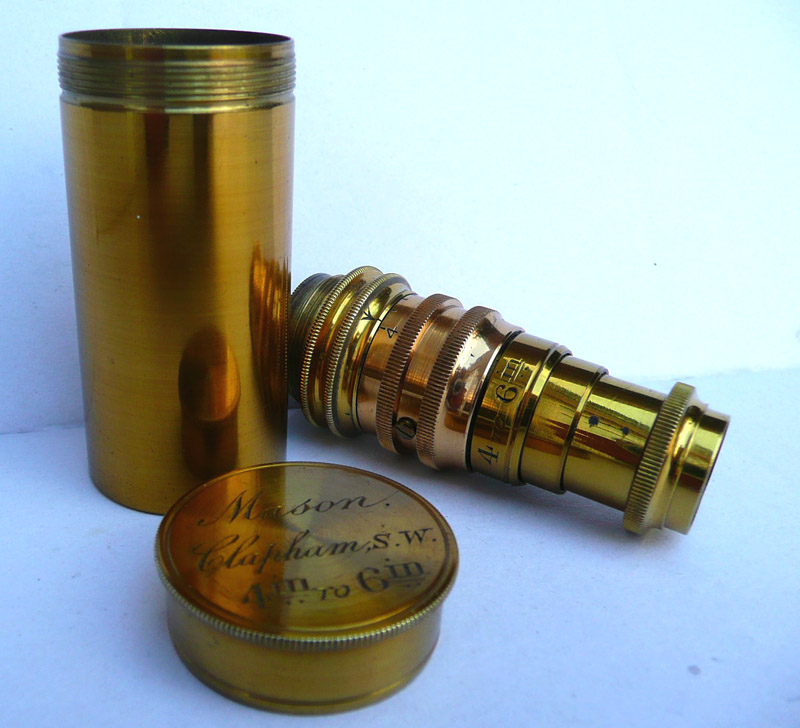
Figure 8.
A microscope objective lens and canister, labeled by R.G. Mason. Image courtesy of William Roy Gibson.
As with so
many other people of his era, Mason developed a strong interest in photography.
He combined his expertise with the microscope and camera to make
photomicrographs, and from them, lantern slides. Two examples of these many
interests are 1896 reports from the Brixton and Clapham Camera Club (of which Mason
was the Club Lanternist), “An Hour with
the Lantern Microscope, by Mr. R.G. Mason .. The
Club does not always devote its meetings to strictly photographic matters, such
as the action of developers and toning baths, or even to ‘Art with a big A’,
but occasionally gets out of the usual routine with a fixture like the present.
Mr. Mason's demonstration was really a natural history lecture, numerous
mounted microscopical specimens of the insect and vegetable world being
projected on the screen, and their peculiarities described. This was followed
by living specimens taken from ponds in the locality, Mr. Mason remarking that
the ‘improvements’ of the County Council made his subjects increasingly
difficult to find. However, he had got together a good selection of
water-mites, water-fleas, and other aquatic insects, the most interesting
exhibits, perhaps, being the circulation of blood as shown in the leg of a
frog, and the water-hydra stretching out its tentacles to capture its prey, and
afterwards devouring the same, an exhibit so realistic as to produce cries of
‘Shame’ from a somewhat susceptible member of the audience. In conclusion, Mr.
Mason received cordial thanks for demonstrating a branch of science so inviting
in its photographic possibilities”, and “At a recent meeting Mr. R.G. Mason read the
following paper on ‘Elementary Photo-micrography’: In introducing this subject
to your notice, I do so with the feeling that it is at present a very limited
branch of photography, but in these days of scientific research there seem to
be very few processes of manufacture in which directly, or indirectly, the
camera or the microscope are not used. The use of the camera in conjunction
with the microscope is most useful for teaching purposes, a method whereby a
faithful image of almost any specimen it is possible to view may be permanently
secured, and used as a diagram or the more popular lantern slide. The only
previous method of copying microscopic specimens was to draw them, either by
means of the camera-lucida, or by looking into the microscope, and then
trusting to memory and skill with the pencil and brush. Some very beautiful
work has been done in this way; but however carefully a subject may be drawn,
it can never present all the detail of a good photograph of the same object.
The question may arise, ‘What is the good of a photomicrograph when obtained to
anyone not a lecturer or teacher’. I can only answer, Very little, if you are
not a lover of nature as revealed by the microscope; but if your taste does lie
in that direction. I can promise that you will have a most fascinating branch
of photography, one that you can pursue in any weather, independent of even
daylight. For elementary work with objectives ranging from 3 in. to 1 in. - these will do almost
any average work - the expense need not be great. A £5 note and a little
home-made apparatus will set any ordinary person up in that direction .. ”.
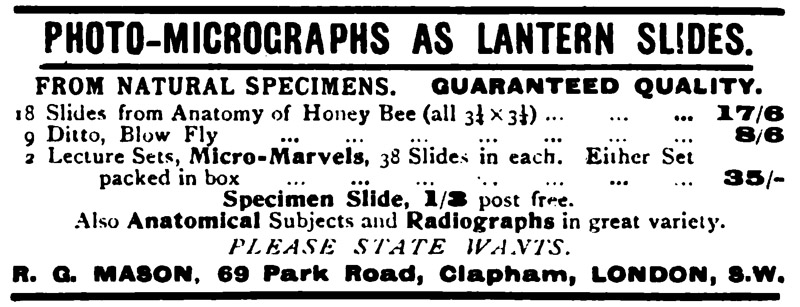
Figure 9.
The merging of Mason’s interests in microscopy and photography. Advertisement from ‘Nature’, 1905.
Robert Mason was still manufacturing microscopes of his own design in 1899. That year, Hardwicke’s Science-Gossip reported, “Mr. R.G. Mason, of 69, Clapham Park Road, sends us an interesting list, which contains several novelties, amongst which we may mention a convertible lantern and table microscope. Most of the microscopes appear to be of good design, and there is a new model specially designed for the use of teachers, which is called ‘The
Champion’, concerning which we can speak favourably after a personal
inspection. It is on a tripod form of foot, has diagonal rack coarse
adjustment, and lever fine adjustment, draw-tube, sub-stage tube for condenser,
and the usual mirrors. The workmanship is sound and the price of the stand
alone is only £3 13s. 6d. We may also call attention to Mr. Mason's sets of
mounted slides for students, and lantern slides for lecturers, specimens of
which have been submitted to us, and which are both good and reasonable in
price. Beginners will find the various series of prepared but unmounted objects
excellent practice, and we note with approbation that these have been, in each
case, sent out still moist from the final clearing stage”.
However,
the 1901 English census listed Mason as being a “worker”, rather than employer or self-employed, indicating that he
had returned to working for another optical business.
As noted
above, Mason continued to produce slides and slide material until near the time
of his death. In 1906, Knowledge and
Scientific News reported, “Mr. R.G. Mason, of 69, Clapham Park
Road, S.W., sends me specimens of a series of interesting objects ready
prepared for mounting, or requiring only soaking in spirits of turpentine
beforehand. These are very suitable for beginners, and others would do well to
obtain the list and peruse it, as by obtaining some of these sections they can,
with a minimum of trouble and expense, add many interesting slides to their
cabinets. Many of the botanical sections are double stained, nearly all are
arranged in typical sets, and the cost only averages from one penny to three
halfpence per slide. Full directions for mounting are sent with each series.
Mr. Mason also sends me specimens of completely mounted objects, amongst which
I may mention a fine section of limestone from Llanymynéch showing unusually
perfect fossil remains”.
Around
1909, Mason, his wife and 3 of their unmarried children moved from Clapham to
78 Foxbourne Road, in the Upper Tooting area of London. Robert died on April 3,
1912, at the age of 62.

Figure 10.
Advertisement for Mason's microscopes, from the 1895, second edition of Arthur C. Cole’s
"Methods of Microscopical Research"
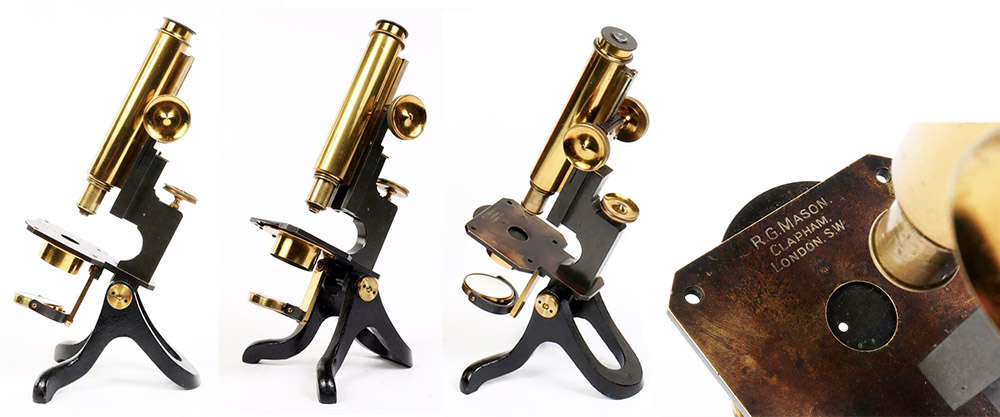
Figure 11.
Mason's "Histological and Botanists' Microscope", circa 1895 (see Figure 10). Adapted for nonprofit, educational purposes from an internet auction site.

Figure 12.
Compound and simple dissecting microscope by R.G. Mason, circa 1890. Adapted for nonprofit, educational purposes from an internet auction site.
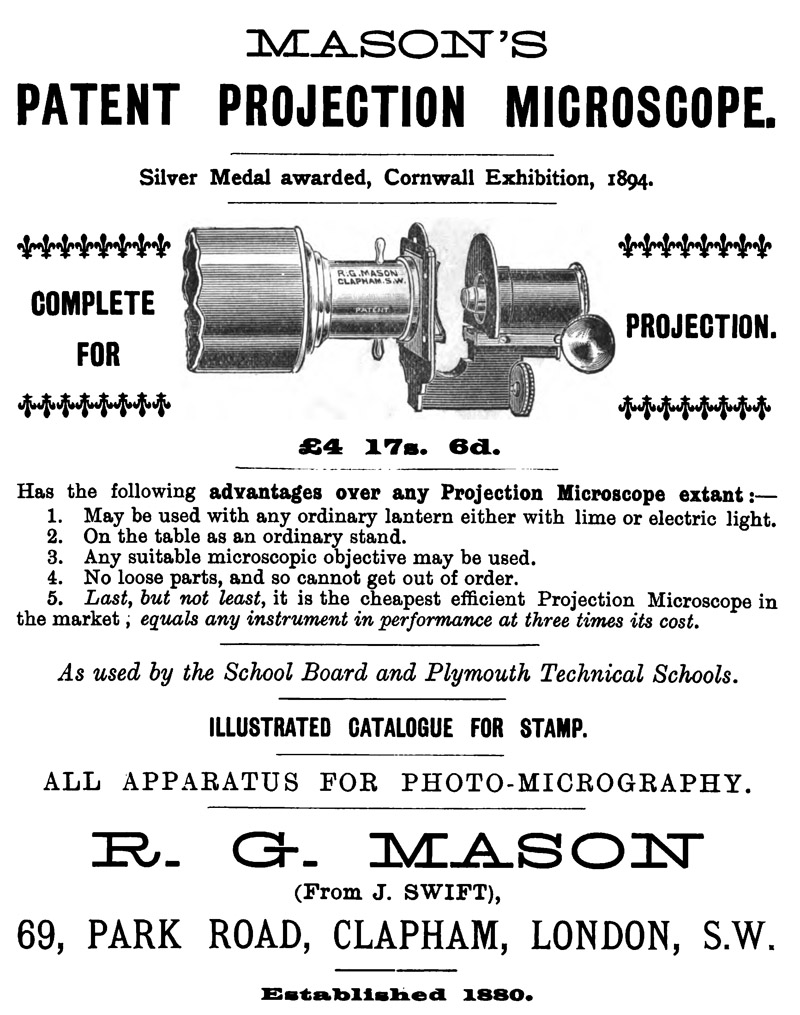
Figure 13.
An 1895 advertisement for Mason's projection microscope, from the second edition of Arthur C. Cole’s
"Methods of Microscopical Research"
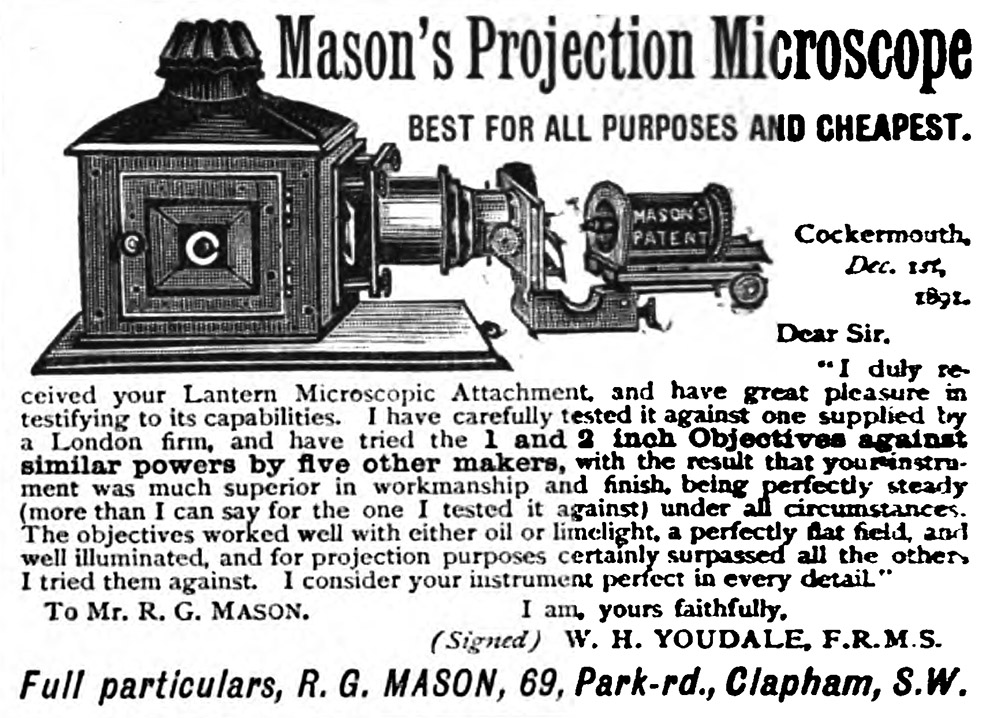
Figure 14.
An 1892 advertisement, from "Hardwicke's Science-Gossip".
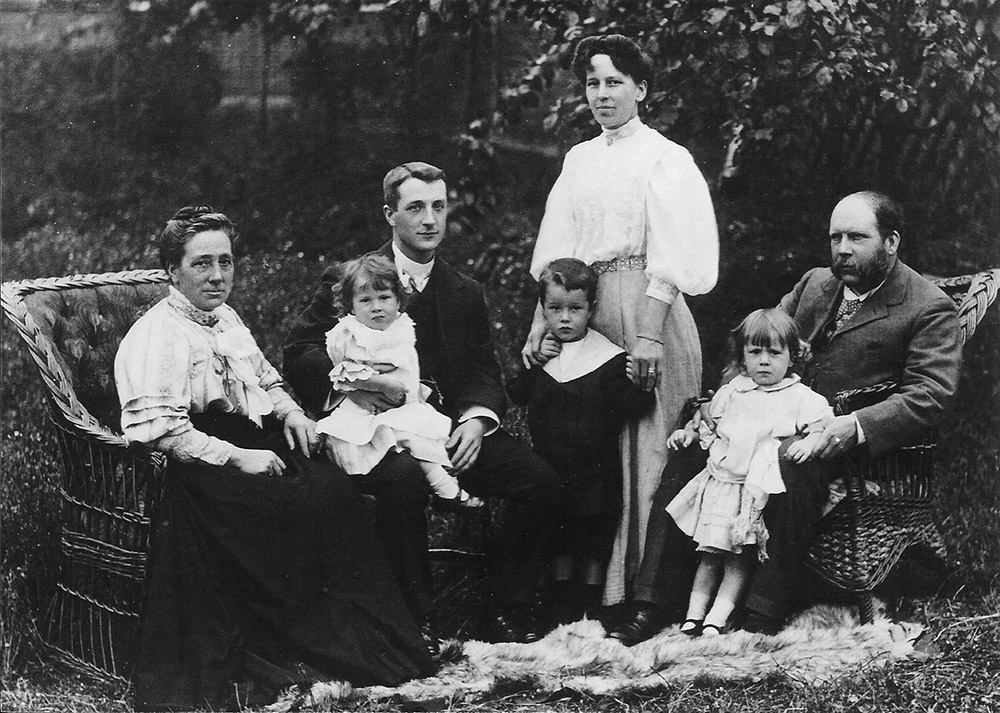
Figure 15.
Circa 1910 photograph of R.G. Mason and his family. The adults are (from left to right) Robert's wife, Elizabeth, son Joseph Bromley Mason, Joseph's wife, Ellen, and Robert. The three children are the daughters and son of Joseph and Ellen. Image generously provided by R.G. Mason's great-grandaughter, Lindsay Groom.
Acknowledgements
Many thanks to Lindsay Groom and William Roy Gibson for their generosity in providing images for this essay.
Resources
Bracegirdle, Brian (1998) Microscopical Mounts and Mounters, Quekett Microscopical Club,
London, pages 65 and 154, plate 25 slides J and K (K was prepared by Mason, J
was produced by the Morphological Laboratory and carries Mason’s address label, probably a resale)
Cole, Arthur C. (1895) The
Methods of Microscopical Research, second edition, advertisements from R.G.
Mason at rear of the book
Cornwall Polytechnic
Society Annual Report (1893) Descriptions of prizes awarded at exhibition:
Lantern and table microscope, R.G. Mason, Second Silver Medal, “In microscopes some perfectly finished and
most admirable instruments and devices were shown by Mr. Mason, of Clapham,
whose arrangements for combined use in his oxy-hydrogen lantern and table
microscopes are unrivalled in handiness, excellence, and efficiency. There are
two forms, one being specially adapted to take the large photographic
astronomical slides. The end attained is the same in both, namely, the
provision of an instrument which can be used to demonstrate before a large
audience, while when it is not in use in that way it is easily convertible into
an ordinary form of table stand, the lantern fitting being slid off and another
stand and body substituted”, pages 46-48
England birth, marriage, and death records, accessed through
ancestry.co.uk
English Mechanic and World of Science (1882) Sixpenny Sale advertisements from R.G. Mason, Vol. 36, November 24 and December 1 issues
English Mechanic and World of Science (1883) Sixpenny Sale advertisements from R.G. Mason, Vol.
36, pages 466, 512, 536 and 604
English Mechanic and World of Science (1883) Sixpenny Sale advertisements from R.G. Mason, Vol.
37, pages 44, 118, 140, 302 and 350
English Mechanic and World of Science (1883) Sixpenny Sale advertisement from R.G. Mason, Vol.
38, November 23 issue
English Mechanic and World of Science (1892) Sixpenny Sale advertisements from R.G. Mason, Vol.
54, page 452
Gill, Steve (2008) The Adye enigma, Quekett Journal of Microscopy, Vol. 40, pages 685-694
Gill, Steve (2009) The Ady(e)
enigma - resolved, Quekett Journal of
Microscopy, Vol. 41, pages 121-131
Hardwicke’s Science-Gossip (1882)
Exchange offers from R.G. Mason, Vol. 18, pages 72 and 96
Hardwicke’s Science-Gossip (1883)
Editor’s note on anatomical objects offered by R.G. Mason, Vol. 19, page 66
Hardwicke’s Science-Gossip (1883)
Advertisement by R.G. Mason, Vol. 20, January issue, page vi
Hardwicke’s Science-Gossip (1886)
Exchange offers from R.G. Mason, Vol. 22, pages 72, 95 and 144
Hardwicke’s Science-Gossip (1889)
Exchange offers from R.G. Mason, Vol. 25, pages 24 and 95
Hardwicke’s Science-Gossip (1891)
Advertisements by R.G. Mason, Vol. 27, pages xciv and lxxviii
Hardwicke’s Science-Gossip (1899)
Editor’s note on Mr. R.G. Mason’s catalogue, Series 2, Vol. 6, page 248
Hardwicke’s Science-Gossip (1900)
Editor’s note on Mason’s section of limestone slides, Series 2, Vol. 7, page 28
Hardwicke’s Science-Gossip (1901)
Advertisement by R.G. Mason, Series 2, Vol. 8, page 192
Hardwicke’s Science-Gossip (1902)
Advertisement by R.G. Mason, Series 2, Vol. 8, inside cover of March issue and
elsewhere
Journal of Microscopy and
Natural Science (1891) Mason's improved oxyhydrogen lantern and
table microscope, Vol. 10, pages 119-121
Journal of the Royal
Microscopical Society (1891) Mason's improvements in oxy-hydrogen microscopes,
pages 89-90
Kelly’s Directory of
Chemists and Druggists (1885) Microscope Manufacturers .. Mason Robert
George, 24 Clapham park rd sw, Fifth edition, page 350
Knowledge (1910)
Advertisement from R.G. Mason, Vol. 33, December issue inside front cover
Knowledge (1911)
Advertisement from R.G. Mason, Vol. 34, page 498
Knowledge and Scientific News (1906) Editor’s note on Mason’s slides and specimens for
mounting, New series, Vol. 3, page 337
Knowledge and Scientific News (1908) Advertisement by R.G. Mason, New series, Vol. 5,
page xii
Marriage record of Robert George Mason and Elizabeth Mary
Lugger (1875) Poplar All Saints parish records
Mason, Robert G. (1891) Ebonising brass, English Mechanic and World of Science,
Vol. 53, page 210
Mason, Robert G. (1891) Spoiled brass, English Mechanic and World of Science, Vol. 53, page 211
Mason, Robert G. (1891) Cement for fresh-water aquarium, English Mechanic and World of Science,
Vol. 53, page 232
Mason, Robert G. (1891) Ophthalmic, English Mechanic and World of Science, Vol. 53, page 233
Mason, Robert G. (1891) Cuticle of leaves, English Mechanic and World of Science,
Vol. 53, page 278
Mason, Robert G. (1891) Microscopic – the splitting of
selenite, English Mechanic and World of
Science, Vol. 53, page 298
Mason, Robert G. (1891) Mirror, English Mechanic and World of Science, Vol. 53, page 343
Mason, Robert G. (1891) Case-hardening iron, English Mechanic and World of Science,
Vol. 53, page 366
Mason, Robert G. (1891) Solder for gun-metal, English Mechanic and World of Science,
Vol. 53, pages 389-390
Mason, Robert G. (1891) Microscopical, English Mechanic and World of Science, Vol. 53, page 436
Mason, Robert G. (1891) Mounting microscopic objects, English Mechanic and World of Science,
Vol. 54, page 226
Mason, Robert G. (1891) Gun-metal castings, English Mechanic and World of Science,
Vol. 54, page 271
Mason, Robert G. (1891) Plating solution, English Mechanic and World of Science,
Vol. 54, page 291
Mason, Robert G. (1891) Microscopical, English Mechanic and World of Science, Vol. 54, page 293
Mason, Robert G. (1891) Do
I Require Spectacles, 12 pages, printed by F. Shaw & Co. (reference
from Google Books)
Mason, Robert G. (1896) Elementary photo-micrography, The Photographic News for Amateur
Photographers, Vol. 40, page 124
Mason, Robert G. (1899) Practical hints
on mounting, American Monthly
Microscopical Journal, Vol. 20, pages 38-48
Museum of the History of Science (accessed 2013) Image and
information on a Mason projection microscope, http://www.mhs.ox.ac.uk/collections/search/displayrecord/?mode=displaymixed&module=ecatalogue&invnumber=10209&irn=16296&query=
Nature (1906)
Advertisements by R.G. Mason, Vol. 74, pages xi and xxvii
Pharmaceutical Journal (1898)
Exhibition of optical, mathematical, and scientific instruments, “R.G. Mason, of 69, Clapham Park Road, S.W., a trade
maker, shows microscopes, etc.”, Vol. 61, page 402a
The Photographic Dealer (1898)
Optical trades exhibition, “R.G. Mason, 69 Clapham Park Road, Clapham, S.W. In this case a
strong exhibit of objects prepared for the microscope were on view”, Vol.
5, pages 81-82
The Photographic News for
Amateur Photographers (1896) Report of meeting of the Brixton and Clapham Camera Club, Vol. 40, page 744
Probate record of Robert George Mason (1912) accessed
through ancestry.co.uk
Stevenson, Brian and Steve Gill (2013) The many lives of Heinrich Hensoldt (1856 – ca. 1918),
Moritz Hensoldt’s errant son, Quekett Journal of Microscopy, In press
The Students’ Journal and
Hospital Gazette (1883) Advertisement of slides for sale by R.G.
Mason, Vol.11, page 221
Work (1893)
Sale and Exchange advertisement from R.G. Mason, Vol. 6, page 174














